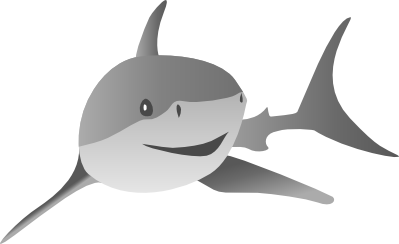Hello World¶
In this section you will write your first program with Shark.
LDA classification¶
Using a Linear Discriminant Analysis (LDA) as Hello-World (or
Hello-Shark) program, we will try to separate two classes of inputs
using a simple linear function. The code for this tutorial can be
found in quickstartTutorial.cpp in the
examples/Supervised folder.
In order to access the LDA, we include its header file and import the Shark namespace for convenience. We will also need the header for importing CSV files:
#include <shark/Data/Csv.h>
#include <shark/Algorithms/Trainers/LDA.h>
#include <shark/ObjectiveFunctions/Loss/ZeroOneLoss.h>
using namespace shark;
Data preparation¶
Next we would like some data to classify. We can use the Dataset
class for holding the data, and load the data with importCSV:
ClassificationDataset data;
try {
importCSV(data, argv[1], LAST_COLUMN, ' ');
}
catch (...) {
cerr << "unable to read data from file " << argv[1] << endl;
exit(EXIT_FAILURE);
}
The first line creates a dataset, the data structure used in Shark for holding
data for supervised learning tasks. Such containers hold pairs
of input data points and labels. The ClassificationDataset used here is
simply a typedef for
LabeledData < RealVector, unsigned int >, as we will use real-valued feature
vectors and integer labels (see the LinAlg tutorials
for more information on RealVector). The second line loads the data file.
For example, let us consider the data in
C.csv.
To apply the Shark program to these data, you have to pass the filename as a command line option, e.g.:
./quickstartTutorial data/quickstartData.csv
If you open that file you will see that it contains the label information in the last
column while the preceding two columns represent the input data points. For this reason,
the argument LAST_COLUMN was passed to importCSV. The data formats supported by
Shark are in detail described in the data tutorials.
We want to use only one part of all available data for training, and set aside another part for testing. The next line splits (i.e. removes) a test set from our loaded data and stores it inside a new dataset. We choose the training set to be 80% of the available data:
ClassificationDataset test = splitAtElement(data,static_cast<std::size_t>(0.8*data.numberOfElements()));
After this operation, data is only 80% of its former size, and test holds the
remaining 20%. See the data tutorials for similar
such operations.
Declaring a model and trainer¶
Shark strictly separates the concepts of models and optimizers. This means that we need to declare a learning algorithm and the right model for it separately (see more information about the building blocks and implementation design rationales in the concept tutorial Optimizers and Trainers). Since the LDA uses a linear classifier, we declare an instance of such. It is not needed to specify the dimensionality of the input data or the number of classes of our problem, the LDA will infer this from the training data itself. The LDA is a separate entity playing the role of a trainer.
//create a classifier for the problem
LinearClassifier<> classifier;
//create the lda trainer
LDA lda;
To optimize the model given the training data and using a specific trainer we write
lda.train(classifier,data);
After this call, our classifier can directly be used to classify data. But we do not know how good our solution is, so let’s evaluate it.
Evaluation¶
One way to evaluate our LDA-trained linear model is to count the number of correctly classified test samples. Here, we use a loss function to evaluate the fration of incorrectly classified points:
ZeroOneLoss<> loss;
double error = loss(test.labels(),classifier(test.inputs()));
The result should read:
RESULTS:
========
test data size: 200
error rate: 0.225
What you learned¶
You should have learned the following aspects in this Tutorial:
- What the main building blocks of a general optimization task are: Data, Error Function, Model, Optimizer
- How to load data from from a csv file.
During the course of all tutorials, you will gain a more fine grained knowledge about these different aspects.
What next?¶
In the next tutorial we will investigate how General Optimization Tasks are set up, which gives you a deeper understanding of the main building blocks of Shark.


